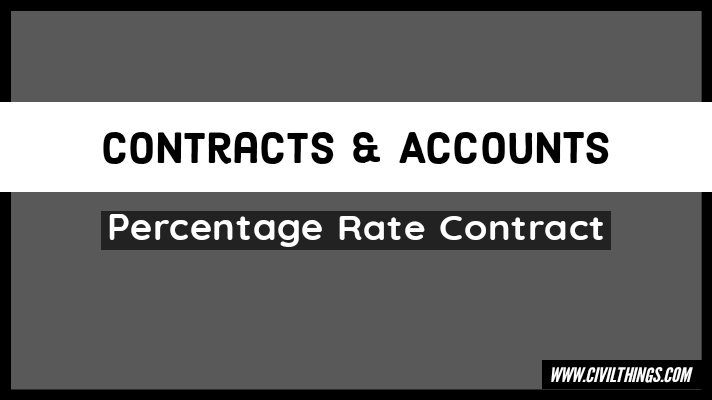A percentage rate contract, simply put, is a type of contract used in construction or similar projects where the contractor is paid a percentage of the total project cost. Instead of a fixed price, the contractor receives a percentage of the total cost, including materials, labor and other costs. This can be beneficial when the exact scope of work is not known in advance, as pricing can be flexible as the project progresses.
Table of Contents
Percentage rate contract
It is a modified form of the Item rate contract. This Bill of quantities (schedule B) consists of a description of the Item as per sanctioned estimate with their quantities, rates, unit, and amount.
The contractor is asked to quote only the percentage above or below or as per the rates shown in the schedule. The same percentage figure applies to all the items.
The additional benefit of this type over the item rate contract is that there is no possibility for an unbalanced tender.
Advantages:
As there is no provision to quote the contractor’s rate for an individual item, benefit due to increased quantity with a beneficial rate can not be availed of by a contractor.
The comparative statement can be prepared quickly. Overwriting and erasing rates etc. can be avoided.
Disadvantages:
In this type of contract, contractors compete for the tender by quoting their percentage rates. In that, an uncertain or unworkable rated tender may be the lowest. To cancel such the lowest tender time, approval from a higher authority is required. On the other hand, if such tender is accepted, there is uncertainty about quality, smooth progress, and completion of work.
Tenderers can easily form a ring. This leads to the drainage of Government Money.
By negotiation among the contractors, two or more of them may quote the same rate to get a part of the work at a high rate. Thus there is administrative difficulty to allot the whole work to any one of the contractors. Also, there is a technical difficulty; more labor is required.
The total cost of work is not known unless work is completed.
In this method, the owner maintains the complete record of expenditure incurred on construction work, and the contractor is paid a certain percentage of it as his fees. According to how such fees are paid to the contractor, this method is further classified as follows,
Type of Percentage rate contract
1. cost plus percentage rate contract.
2. cost plus fixed fee contract.
3. cost plus variable percentage contract.
4. cost plus variable fee contract.

1. cost plus percentage rate contract:
In this type of contract, the owner agrees to pay the contractor the actual cost of the work plus an agreed percentage of the cost as his profit. The various contract documents, drawings, bills of quantities, and specifications are not necessary at the time of signing the agreement. These can be supplied to the contractor from time to time. The payment to the contractor is made periodically based on the cost of material and labor on the advice of the engineer.
Advantages:
1) Early completion of work.
2) Disputes due to the extra item are eliminated.
3) Suitable for private works.
4) Quality of work is maintained.
5) There is no extra item.
6) No excess payment to the contractor.
Disadvantages:
1) Total cost of work is not known till the completion of work.
2) There is no incentive to the contractor for early completion of work and affecting the economy.
3) Employment of large staff by both parties.
2. Suitability and Unsuitability:
This type of contract is suitable for emergency work, works involving difficult foundation conditions, and the construction of expensive structures. However, this type of contract is not suitable for Government works and works of public bodies.
Cost plus fixed fee contract:
In this type of contract, the owner agrees to pay the contractor the actual cost of the work plus a certain fixed amount as his fee. In this contract documents are not necessary while signing the agreement. These are supplied during the progress of work. The payment to the contract is made periodically based on the cost of material, labor, plants, and equipment used plus his fee.
Advantages:
1. Early completion of work.
2. Quality of work is maintained.
3. There is no extra item.
4. Dispute due to extra item is eliminated.
Disadvantages:
1. There is no incentive to the contractor for early and economic completion of work.
2. Final cost is not known unless the work is completed.
3. Employment of large staff for keeping accounts.
Suitability and Unsuitability:
This type of contract is suitable for emergency work; works involving difficult foundations, construction of expensive structures.
However, this type of contract can not be adopted for weeks belonging to Government and public bodies.
3. Cost plus variable percentage contract:
In this method payment to the contract is made on a varying percentage basis. The contractor’s percentage is linked with the cost of construction. It increases or decreases with the decrease or increase in the cost of construction from the estimated amount. Thus he gets more profit if he can bring down the cost of construction and (he gets) less profit if the actual cost of construction exceeds the estimated amount.
This type of contract is similar to a cost-plus percentage rate contract except that payment to the contract is made on a varying or fluctuating percentage basis.
Advantages:
1. Contractor gets more profit if he can make economic completion of work.
2. Early completion of work.
Disadvantages:
1. If the contractor does not make economic completion of work, he gets less profit or more loss.
4. Cost plus variable fee contract:
This type of contract is similar to cost plus fixed fee contract except that an element of incentive to the contractor is introduced for early and economical completion of work. This element of incentive overcomes the main drawback of the cost plus percentage and cost plus fixed fee contract.
The fees to be paid to the contractor are not fixed but it fluctuates concerning the actual cost of work. The higher the actual cost lower the fee and vice versa. In all other respect, this type of contract is similar to a cost-plus-fixed-fee contract.
Advantages:
1. In this case a contractor shall not try to increase actual cost. The actual cost is thus lower and lower so both the owner and contractor will be benefited.
2. Early completion of work.
Disadvantage:
The estimated cost must be very accurately determined. If the estimated cost exceeds the actual expenses due to the inefficiency of the estimator, the contractor will receive additional compensation based on the savings, and vice versa.
Important Links
Bamboo crash barrier used in National Highway Construction
15+ Trending Admixtures used in Construction
Highly Used Cement Type in National Highway Construction
TYPES OF CONTRACT | DIFFERENCE | ADVANTAGES | DISADVANTAGES
What Is Construction Contract | Types of Engineering Contracts | Percentage-Rate Contract
FAQ:
Q1.Explain the percentage rate contract.
Q2.Explain the cost plus percentage rate contract with two advantages and disadvantages.
Q3.What is a cost-plus percentage rate contract?
Q4.What is a cost-plus-fixed-fee contract?
Q5.What is a cost-plus variable percentage contract?
Q6.What is a cost-plus variable-fee contact
Boost your Knowledge of Percentage rate of contract
| Question | Answer |
|---|---|
| Q1: Explain the percentage rate contract. | A percentage rate contract is an agreement where the contractor is paid a certain percentage of the total project cost as their fee. The fee is calculated based on the actual cost of the work performed… |
| Q2: Explain the cost-plus percentage rate contract with two advantages and disadvantages. | Advantages: 1. Flexibility for scope changes. 2. Incentive for the contractor to control costs. Disadvantages: 1. Potential for higher overall project cost. 2. Limited cost control measures… |
| Q3: What is a cost-plus percentage rate contract? | A cost-plus percentage rate contract is an agreement where the contractor is reimbursed for their actual costs and is paid a percentage of these costs as a fee for their services… |
| Q4: What is a cost-plus-fixed-fee contract? | A cost-plus-fixed-fee contract is an agreement where the contractor is reimbursed for their allowable costs and is paid a fixed fee, providing a guaranteed profit… |
| Q5: What is a cost-plus variable percentage contract? | There is no widely recognized concept of a “cost-plus variable percentage contract.” It is possible that variations in terminologies or local practices may lead to different interpretations… |
| Q6: What is a cost-plus variable-fee contract? | A cost-plus variable-fee contract is an agreement where the contractor is reimbursed for their allowable costs, and the fee they receive is variable and may be adjusted based on performance, project outcomes, or other predetermined criteria… |

Hi! I’m Sandip, a civil engineer who loves sharing about Civil Engineering & new ideas and tips. My blog helps you learn about engineering in a fun and easy way!

